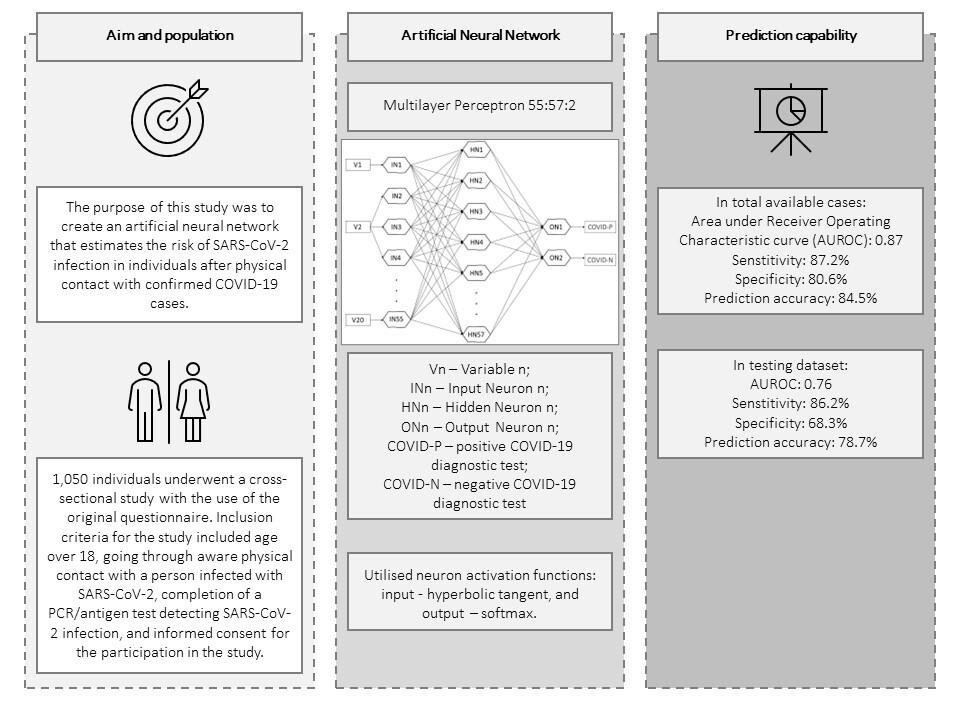Current issue
Archive
Manuscripts accepted
About the Journal
Editorial office
Editorial board
Section Editors
Abstracting and indexing
Subscription
Contact
Ethical standards and procedures
Most read articles
Instructions for authors
Article Processing Charge (APC)
Regulations of paying article processing charge (APC)
COVID-19/SARS-COV-2 / CLINICAL RESEARCH
The possibilities of prospective assessment of SARS-CoV-2 infection risk based on an artificial neural network model – a cross-sectional and in silico study
1
Students Research Group at the Chair and Department of Epidemiology and Clinical Research Methodology, Medical University of Lublin, Poland
2
Department of Epidemiology and Clinical Research Methodology, Medical University of Lublin, Lublin, Poland
Submission date: 2022-11-24
Final revision date: 2023-01-03
Acceptance date: 2023-01-16
Online publication date: 2023-04-09
Corresponding author
Sylwiusz Niedobylski
Students Research Group at the Chair and Department of Epidemiology and Clinical Research Methodology, Medical University of Lublin, ul. Radziwiłłowska 11, 20-080, Lublin, Poland
Students Research Group at the Chair and Department of Epidemiology and Clinical Research Methodology, Medical University of Lublin, ul. Radziwiłłowska 11, 20-080, Lublin, Poland
KEYWORDS
TOPICS
ABSTRACT
Introduction:
The prediction of how an infection of a new pathogen, such as SARS-CoV-2, will evolve using traditional modelling methods may turn out to be unattainable, although it could be achievable using in silico techniques. The purpose of this study was to create an artificial neural network that estimates the risk of SARS-CoV-2 infection in individuals after physical contact with confirmed COVID-19 cases.
Material and methods:
A cross-sectional study was conducted with an original 118-item questionnaire. Information concerning participants’ demographics, the circumstances of the contact with an infected person, general medical history, lifestyle, preventive behaviours, and the result of the COVID-19 test after the contact was obtained. The study included 1050 participants. The data were used to train and validate an artificial neural network. The project was funded by the Ministry of Education and Science as part of the “Studenckie Koła Naukowe Tworzą Innowacje” student competition (project no. SKN/SP/496779/2021).
Results:
The model in the analysis of total available cases had an area under the receiver operating characteristic curve (AUROC) of 0.87, sensitivity of 87.2%, specificity of 80.6% and prediction accuracy of 84.5%. The model shows a high capacity for generalisation – in the testing data set: AUROC 0.76, sensitivity 86.2%, specificity 68.3%, prediction accuracy 78.7%.
Conclusions:
The developed tool is capable of high quality generalisation of the collected data, which translates into its ability to assess the risk of SARS-CoV-2 infection in a person after contact with a COVID-19 case. It has been deployed as an online calculator available on: https://www.umlub.pl/uczelnia/struktura-organizacyjna/szczegoly,317.html
The prediction of how an infection of a new pathogen, such as SARS-CoV-2, will evolve using traditional modelling methods may turn out to be unattainable, although it could be achievable using in silico techniques. The purpose of this study was to create an artificial neural network that estimates the risk of SARS-CoV-2 infection in individuals after physical contact with confirmed COVID-19 cases.
Material and methods:
A cross-sectional study was conducted with an original 118-item questionnaire. Information concerning participants’ demographics, the circumstances of the contact with an infected person, general medical history, lifestyle, preventive behaviours, and the result of the COVID-19 test after the contact was obtained. The study included 1050 participants. The data were used to train and validate an artificial neural network. The project was funded by the Ministry of Education and Science as part of the “Studenckie Koła Naukowe Tworzą Innowacje” student competition (project no. SKN/SP/496779/2021).
Results:
The model in the analysis of total available cases had an area under the receiver operating characteristic curve (AUROC) of 0.87, sensitivity of 87.2%, specificity of 80.6% and prediction accuracy of 84.5%. The model shows a high capacity for generalisation – in the testing data set: AUROC 0.76, sensitivity 86.2%, specificity 68.3%, prediction accuracy 78.7%.
Conclusions:
The developed tool is capable of high quality generalisation of the collected data, which translates into its ability to assess the risk of SARS-CoV-2 infection in a person after contact with a COVID-19 case. It has been deployed as an online calculator available on: https://www.umlub.pl/uczelnia/struktura-organizacyjna/szczegoly,317.html
Share
RELATED ARTICLE
We process personal data collected when visiting the website. The function of obtaining information about users and their behavior is carried out by voluntarily entered information in forms and saving cookies in end devices. Data, including cookies, are used to provide services, improve the user experience and to analyze the traffic in accordance with the Privacy policy. Data are also collected and processed by Google Analytics tool (more).
You can change cookies settings in your browser. Restricted use of cookies in the browser configuration may affect some functionalities of the website.
You can change cookies settings in your browser. Restricted use of cookies in the browser configuration may affect some functionalities of the website.



